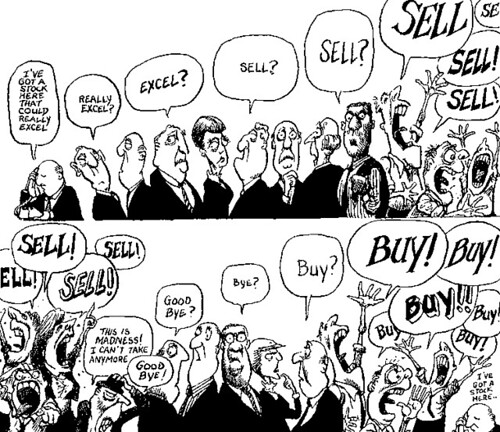
I was about to write a brief post that sums up the difficulty of eliminating the federal budget deficit when I ran across a rather lengthy but a very clearly written article by Chris Farrell of the Market Money fame program on Public Radio. I think that you will benefit from reading his unabridged post. As this article makes clear and as we have hinted at in class the most significant obstacle to overcome; not that the others are easy; is the level of expenditures related to Medicare.
The size of the federal deficit is repeated so often by politicians and the news media that it's easy to become numb to the sheer magnitude of the number — an estimated $1.29 trillion for the fiscal year which ended on September 30, according to the new figures released today by the Obama Administration.
While that's a drop from the record $1.4 trillion deficit recorded for fiscal 2009, it's still the second largest deficit in history. No one is happy about the tidal wave of red ink:
* The issue helped Tea Party activists angry about out the deficit to seize the political spotlight.
* The Republican's "Pledge to America" promises to "stop out-of-control spending and reduce the size of government" if the party wins big in the November mid-term elections.
* President Obama on a recent stop in Richmond, Va., talked about the need to "get control of our budget.
Here's the rub: The deficit-hating oratory is heated but the deficit-reducing specifics are glaringly absent.
"The turn hasn't gone from highlighting the deficit to actually doing something about it," says Maya MacGuineas, president of the Committee for a Responsible Federal Budget in Washington, D.C. Adds Veronique de Rugy, senior research fellow at the Marcatus Center at George Mason University: "We are still in the realm of rhetoric."
The reason for the reluctance? Simple political calculation. As the late Nobel laureate Milton Friedman was fond of saying, "there is no free lunch." Or, as Mick Jagger of the Rolling Stones, a graduate of the London School of Economics, put it, "you can't always get what you want."
Eventually, however, the size and rapid growth of the deficit mean that it will have to be dealt with and that painful trade-offs will have to be made. The only real question is whether those decisions get made before the U.S. tumbles into a fiscal crisis.
"Those who say this won't be good for me because I'll pay higher taxes or I'll get a smaller benefit ignore the fact that we can't keep doing what we're doing," says James Horney Center on Budget and Policy Priorities.
So what are the realistic options? You won't get many details from the majority of the politicians up for election on Nov. 2, but here are some of the ideas making the rounds in Washington:
Let the Bush Tax Cuts Expire
It's easy to fall into deep despair about the deficit, but Obama's former budget director, Peter Orszag, recently grabbed the fiscal spotlight with a remarkably easy solution: Let the 2001 and 2003 tax cuts expire for everyone.
By allowing taxes to return to the pre-Bush era levels for taxpayers, the federal budget would be close to balance by 2015.
"If we actually ended the Bush-era tax cuts, that would pretty much do it," Orszag said in an interview with CNN's Fareed Zakaria. "If you do a bit on the spending side and then end the tax cuts, you pretty much get there."
The virtue of this approach is that it doesn't require any special legislation or deal-cutting among special interest groups. Congress could then devote its legislative energy to addressing major reforms needed in entitlement programs like Medicare, Medicaid and Social Security, which everyone agrees is necessary.
That said, the idea is DOA. One reason is the risk that higher taxes could send a fragile economy spiraling lower. But the politics may be even more important. Since the earliest days of his campaign, President Obama has committed to not raise taxes on any family earning less than $250,000. Going back on that pledge could be electoral suicide —especially as Republicans are vehemently against all tax hikes. Still, it's an intriguing litmus test to see how serious a politician is about addressing the problem.
What About Other Tax Changes?
Few dispute that America's income tax code is Byzantine, a complicated stew chock full of credits, deductions, phase-ins and phase-outs. Reigning in these so-called "tax expenditures" that clutter up the federal tax code could go a long way toward attacking the deficit "Tax expenditures are bad tax policy," says MacGuineas. She and others point out that a tax credit that reduces Uncle Sam's revenues causes the deficit to rise just as surely as does a spending increase — it's just more politically palatable.
For example, Martin Feldstein, economist at Harvard University and former chairman of the White House Council of Economic Advisors under President Reagan, estimates that simply reducing the size of tax expenditures from the current 6 percent to 4 percent of GDP would bring the projected 2020 debt down from 90 percent to 72 percent.
Sounds good, right? Who doesn't want a cleaner, less complicated tax code (especially come April)? Problem is, these loopholes support many activities people like. For instance, the education credit helps parents save for the high cost of college. The mortgage interest deduction is almost sacred to homeowners. The child care tax credit can be a much needed boon to new parents.
What's more, many Republicans look at moves toward reducing tax expenditures as the equivalent of a tax hike.
Entitlement Reform
America is aging, with the leading edge of the baby boom generation reaching its retirement years. It's well-known that to eventually bring the long-term deficit under control, the government will have to address the three main entitlement programs -- Social Security, Medicare and Medicaid.
Now, despite rhetoric to the contrary, there really is no Social Security crisis. There's financial trouble down the road but it's manageable. Still, the general outline of a compromise for shoring up Social Security's finances has emerged in recent years. It essentially relies on hiking the retirement age, lifting the cap on annual wages subject to the payroll tax, and making the cost of living index less generous. (The Congressional Budget Office offers a list of options in its July 2010 report, Social Security Policy Options at http://www.cbo.gov/ftpdocs/115xx/doc11580/07-01-SSOptions_forWeb.pdf.). Yet many people don't buy into the compromise because it means retiring later or paying more in taxes. Ultimately, however, one — or both — will likely have to happen.
The real long-term budget pressure comes from higher health care spending. To give a sense of the scale of the problem, the benchmark 75-year projection by the Social Security Trustees guesstimates the cost of Medicare alone will swell to 11.4 percent of gross domestic product in 2083 — 94 percent larger than Social Security's cost. "We need to slow the rate of growth in healthcare," says Horney.
He's right, but the kinds of changes in healthcare required to do so will make the controversy over Obamacare a stroll through the park. Salaried doctors? Universal healthcare? Healthcare vouchers for everyone? The debate has only begun.
Cut Back on Defense Spending
Defense accounts for 20 percent of the budget. Last April Defense Secretary Robert Gates targeted more than 20 programs for termination or cutbacks, and the Defense Department is looking for more cuts. A reduction the nation's nuclear arsenal and missile defense systems could end up on the table, while military compensation is another possible target. The reason: military personnel earn average cash compensation that beats 75 percent of their civilian peers of comparable age and education . Benefits are also better than for most civilian jobs. One solution would be to cap the growth future in military compensation at the rate prevailing in the rest of the economy.
"The U.S. spends the biggest share in the world on defense," says the Marcatus Center's de Rugy. "We can cut it a lot."
Yet slashing into defense spending is always difficult, especially with troops at war in Afghanistan and still engaged in a mission in Iraq. Cuts in defense programs also quickly translate into job losses elsewhere in the economy as military contractors cutback — something few politicians willingly allow without a fight.
A Baseline Scenario
Here's one way to start thinking through the trade-offs. A centrist approach was released on Sept. 30 by William Galston of the Brookings Institution and MacGuineas. Their goal is to get debt back down to 60 percent of GDP by the end of the current decade. Their blueprint relies half on spending cuts and half on raising taxes.(http://www.brookings.edu/papers/2010/0930_public_debt_galston.aspx ) They would do everything from slashing deep into defense spending to embracing carbon taxes.
Others would take a very different tack, however. De Rugy, for one, is against raising taxes to tackle the deficit. Instead, she advocates pushing a lot of federal responsibilities back to the states, such as education and transportation, as well as pushing entitlements more toward a private voucher system.
Where do you stand? Would you cut spending? If so which programs would get trimmed? Would you raise taxes? Which ones? Change entitlements? How?
And then there are these questions: When -- if ever -- will politicians stake their fortunes on backing concrete solutions? And if they do, will voters reward them for taking action?
















